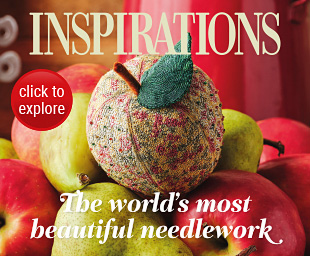Goldwork is probably one of the most awe-inspiring embroidery techniques, and I’m happy to see that its popularity is gaining ground again worldwide.
I have never failed to get ooooooos and aaaaaaahs and wows and all kinds of exclamations when I’ve shown off even the little scraps of practice goldwork. And I admit, that’s always my reaction, too. When I see goldwork, I’m like the crow or whatever it was in that movie I saw when I was a kid – he was always completely mesmerized by “sparklies.” (I think I just dated myself, and demonstrated that I have a pretty foggy memory when it comes to movies from childhood!)
I rank goldwork among my favorite needlework techniques, but the silly thing is, I really haven’t done that much of it! I can count eight goldwork projects I’ve done. That’s it. Eight. That’s not much!
Anyway, one of the reasons goldwork appeals to me, I think, is its rich history. If you’ve never read anything about the history of this opulent form of needlework, but you’d like to, you’re in luck – Country Bumpkin has published a nice, concise article on the History of Goldwork.
When Margaret sent me the link, she commented that the article was probably a result of the recently published A-Z of Goldwork book, and I suppose she’s right. The book hasn’t been distributed in the US yet, but we’re waiting anxiously. I pre-ordered mine through Wooly Thread, and was disappointed to find out that it seems we won’t get them until the end of August (!!). I suppose that’s what I get for saving on shipping and not pre-ordering through Country Bumpkin!
Although I’m anxious to see the book and to compare it with other excellent goldwork books I have – like the Beginner’s Guide to Goldwork by Ruth Chamberline – the truth of the matter is, it’s probably better not to get distracted with a book that’s going to make me want to start Yet One More Project!
Since this post comes without photos, I’ll reference you to this post of a magnificent piece of goldwork…
Enjoy the article!







Why is the color of this goldwork piece a different color? It is much more beautiful than the various metal threads I have, and some of them are pretty high quality. Where can I find this color? What causes the difference in color, the amount of real gold in the thread?
This is a truly incredible work. It blows my mind to see the quality and perfect marriage of the stitching and the techniques/design. Wow.
-Christiana
Mary,
Any idea as to the date of that gold chasuble? And in what country was is made?
Tess
Hi, Christiana –
Remember, the piece is photographed, and my color may not be 100% true (though, actually, it looks right – so I think it is!). And age certainly changes the color, too!
Hi, Tess-
I think the date on it is the late 1800’s, if I remember correctly. I believe there’s a tag inside it, with the name of the place that made it, and the date, but… I didn’t photograph that, unfortunately!
Mary, that is magnificent. As you know I am working on the goldwork Phase of Japanese Embroidery at the moment so I fully appreciate the skill required to stitch something as precisely as this has been worked.
Christiana: gold naturally come is differing shades from very yellow golds to the warmer red golds and even in white! The shade will depend on where the gold was sourced as well as the amount of pure gold in the thread.
CA